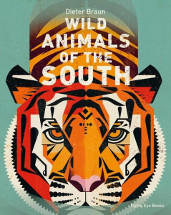Wild animals of the south by Dieter Braun

Flying Eye Books, 2017. ISBN 9781909263970
(Ages: 5+) Australian animals. African animals. South American
animals. Antarctic animals. This is a translated edition of a German
publication, with a second book, Wild animals of the north, also
available. There are many of these artsy, illustration-based
non-fiction books around for children and lots of them are
extraordinary in terms of their visual appeal as well as their
ability to engage young readers, many of whom are becoming more
discerning about the aesthetic qualities of their reading material
as well as shying away from text-heavy books. This one is organised
into four regions: South America, Africa, Asia and Australia. In
keeping with the visual focus, the contents are graphical (using a
map) and the index, organised by region, is pictorial (confusingly
not ordered alphabetically).
The introduction sets a conservationist tone for the reader as it
draws attention to the many species of animal currently threatened
with extinction. It opines 'We are intruders in the animal kingdom
and with every animal that dies out, our life on this planet loses a
part of its power and colour and beauty'. This is a wonderfully
written statement with the power and clarity to resonate with adults
and children alike. The author, by providing breath-taking
illustrations that display their beauty and immenseness, emphasises
that wild animals need to be respected and protected. The
illustrations are not completely realistic, but they are
scientifically accurate and incredibly detailed. The colours are
bright and vibrant, but not always true to life. Many of the
animals, composed of layered geometrical shapes, appear to pop off
the page, piercing you with their intense eyes.
This is a book to appreciate visually but is in no way a reference
or research book. Despite the introduction telling us, 'this book...
tells us how and where they live, what they look like, what they
eat, how they find each other or hide from one another and all the
other things they get up to' the illustrations really are the main
event and they deserve to be. Scientific names are given alongside
common names but aside from this inclusion (which is probably done
to give an exotic feel rather than for educational purpose) minimal
and sometimes no information is given about the included animals.
What information is given is limited in scope and often pertains to
one aspect (e.g. the kookaburra's laugh). In addition, it is far
from comprehensive; it includes only eighteen Australian animals and
a mere eight from the Antarctic region. While clearly not intended
as a reference book, it seems odd that information is not given for
each animal. Nevertheless, this is a beautiful book of art sure to
be treasured by animal lovers and young artists.
Nicole Nelson